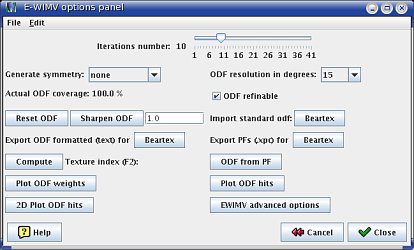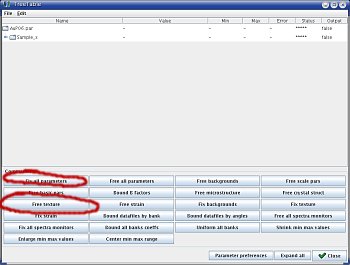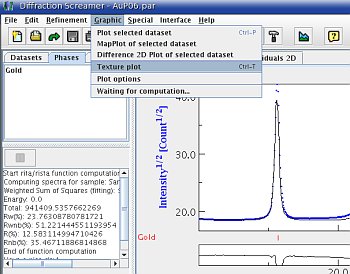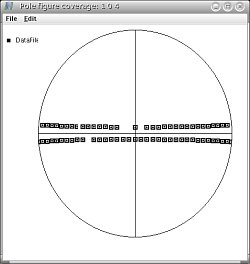|
Texture
In works Memo |
Maud /
Lattice Preferred OrientationsRefinement of Lattice Preferred OrientationsFinally, we do get to the lattice preferred orientations! Do do not attempt to refine texture if the rest of the fit is not stable, you should already have a good match for
before getting into preferred orientations... Displaying LPOAt this point, you probably did not fit LPO, but it usefull to introduce how and where to plot LPO results in MAUD. Basically, everything is accessed in the main window, from the You will find several useful functions such as
 The Advanced Models tab Preferred orientation modelsIn order to apply LPO, select the phase property window, texture is in the Several models could be usefull:
WIMW and E-WIMW are both based on the the discrete WIMW algorithm for determining an orientation distribution function from complete or incomplete pole figures (Matthies and Vinel, 1982). To make a long story short, E-WIMW is an updated version of WIMW. In particular, E-WIMW appears to be more flexible with the experimental pole figure coverage for inverting ODF. Trick!!! In E-WIMW, MAUD normalizes all experimental pole figures. It means that MAUD assumes that the average of the intensity measured for each peak corresponds to that obtained from the structure factors. If your sample is textured and if you do not measure the full pole figure, it won't be the case. You need to remove this option. To do so, click on E-WIMW: no symmetry The E-WIMV Option Panel In general, high pressure textures should display a cylindrical symmetry around the compression axis. However, if you do have strong textures in your sample, MAUD will be able to refine your texture with no imposed symmetry and allow you to actually test this hypothesis. If you do not wish to apply symmetry, the only option to check in the E-WIMV option panel is the  Refine the Texture To refine the texture:
At this point, once again, there is no reciepe, you may want to play with
until you get a decent fit. During the texture adjustment process, make use of the 2-D plot window: it is very usefull to see if the fitted intensities look like the experimental ones. Finally, once you have a fit you like, well, have a look at your pole figures! E-WIMW: symmetryIf you are confident that your dataset should display cylindrical symmetry, you can set this option in the E-WIMV options window. This option is usefull for high pressure experiments as it allows the calculations of inverse pole figures. Never calculate inverse pole figures for ODF with no applies symmetry! This is meaningless! |


